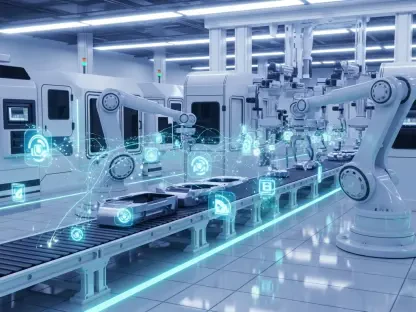The manufacturing sector is increasingly becoming a prime target for cybercriminals, driven by a complex interplay of supply chain disruptions, technological advancements, and inherent cyber vulnerabilities. As manufacturers strive to stay competitive in a rapidly evolving digital landscape, they face significant challenges that heighten their susceptibility to cyber threats, particularly ransomware attacks. These challenges not only expose manufacturers to substantial financial losses but also threaten the seamless operation of interconnected systems vital to the sector. Hence, understanding why cybercriminals are zeroing in on this industry is crucial in order to develop better protective strategies.
The Impact of Supply Chain Disruptions
Manufacturers are heavily reliant on complex supply chains to ensure the timely delivery of raw materials and components. Disruptions to these supply chains, caused by factors such as natural disasters, geopolitical tensions, and pandemics, create vulnerabilities that cybercriminals are all too eager to exploit. When supply chains fail, costs rise and delays become commonplace, compelling manufacturers to devise strategies to navigate these uncertainties while maintaining operational efficiency.
The interconnected nature of supply chains means that a cyberattack on one link can have a cascading effect, impacting multiple organizations down the line. This innate vulnerability makes manufacturing an attractive target for cybercriminals who can leverage these disruptions for financial gain. A ransomware attack can paralyze operations, forcing companies to pay significant ransoms to restore normal functionality. The resulting operational disruptions not only lead to direct financial losses but also damage relationships with suppliers and customers, further escalating the economic impact.
As cybercriminals become more sophisticated, they exploit supply chain vulnerabilities with increasing frequency and effectiveness. These attacks are designed to infiltrate both hardware and software, causing widespread operational damage. Fostering resiliency in this context requires a robust cybersecurity strategy that can anticipate and mitigate the impact of potential supply chain disruptions. Ultimately, manufacturers must build digital fortresses capable of withstanding these relentless cyber onslaughts.
Technological Advancements and Cybersecurity Challenges
The adoption of Industry 4.0 technologies such as automation, artificial intelligence, and smart factory solutions is essential for manufacturers aiming to stay competitive. However, these technological advancements introduce new cybersecurity challenges that cannot be ignored. The integration of the Internet of Things (IoT) and other cyber-physical systems increases the attack surface, making it easier for cybercriminals to penetrate and compromise networks.
By 2030, it is estimated that 29 billion devices will be interconnected, underscoring the critical need for robust cybersecurity measures. The seamless connectivity that drives innovation in manufacturing also serves as an entry point for cybercriminals, who can exploit weaknesses in system design and implementation. The low tolerance for downtime in the industry exacerbates the impact of cyberattacks, as even brief disruptions can lead to significant financial losses and operational inefficiencies.
To safeguard against these emerging threats, manufacturers must invest in comprehensive data protection and system security. This includes not only implementing advanced technological solutions but also ensuring continuous monitoring and updating of security protocols. As cyber threats evolve, so too must the defensive measures designed to thwart them. Maintaining a proactive stance on cybersecurity is not merely a best practice but an operational necessity in today’s hyper-connected manufacturing landscape.
Legacy Systems and Their Vulnerabilities
Many manufacturers continue to rely on legacy systems that were not designed with modern cybersecurity threats in mind. These outdated technologies often lack the latest security features and updates, rendering them vulnerable to attacks. As the original developers of these systems are no longer in a position to provide necessary security patches, the risk of breaches significantly increases.
While maintaining legacy systems may seem cost-effective initially, the potential costs of a cyberattack can far outweigh the perceived savings. Cybercriminals can exploit these vulnerabilities to gain access to sensitive data or disrupt operations, leading to devastating financial losses and damage to the company’s reputation. For manufacturers, the calculus must shift from short-term savings to long-term risk management, which often necessitates upgrading systems to enhance security and resilience.
In today’s threat landscape, the continued use of legacy systems presents a substantial cybersecurity risk. The gap in security measures can be a weak link that cybercriminals are quick to identify and target. Manufacturers must prioritize updating their technological infrastructure, not only to stay competitive but also to protect against the growing array of cyber threats. Investing in modern, secure systems is an essential step in mitigating risks and ensuring the long-term viability of manufacturing operations.
The Prevalence of Ransomware Attacks
Ransomware attacks have become an increasingly common and lucrative tactic for cybercriminals targeting the manufacturing sector. According to recent reports, manufacturing accounted for nearly a quarter of all cyber incidents globally in 2023, with a staggering 638 ransomware attacks recorded. The prevalence of these attacks highlights the urgency for manufacturers to fortify their cybersecurity frameworks to better withstand and recover from such incidents.
A stark example of the devastating impact of ransomware is the 2023 attack on Clorox, which led to major disruptions in the company’s automated systems. This breach affected large retailers like Walmart and Target, resulting in a $356 million loss for Clorox due to a 20% decline in sales, a sharp drop in stock price, and a $25 million expenditure on post-breach security measures. This incident underscores the severe financial and operational consequences ransomware can inflict on manufacturers.
Ransomware attackers often deploy supply chain infiltration techniques, leveraging compromised hardware and software to spread their malicious reach. The escalating frequency and sophistication of these attacks make it clear that manufacturers must adopt comprehensive cybersecurity measures that include not only prevention but also swift recovery mechanisms. Building resilience against ransomware is not optional; it is a critical aspect of sustaining business operations and protecting stakeholder interests.
Additional Cyber Threats: Phishing and Data Theft
In addition to ransomware, manufacturers face a myriad of other cyber threats, including phishing attacks aimed at stealing sensitive information. These attacks target bank details, Social Security numbers, and credit/debit card information, coercing victims into transferring money directly to cybercriminals’ accounts. Phishing attacks are not just about immediate financial gain; they can also severely damage a company’s reputation and lead to long-term operational disruptions.
Phishing attacks often serve as a conduit for spreading malicious software, which can further complicate the cybersecurity landscape for manufacturers. The combination of ransomware and phishing creates a high-stakes environment where continuous vigilance is required. Addressing these threats necessitates a multifaceted approach that includes employee training, advanced detection systems, and an overall culture of cybersecurity awareness within the organization.
Comprehensive security measures are critical to safeguarding manufacturing operations and data from these pervasive threats. Manufacturers must invest in both technology and training, ensuring that their workforce is equipped to recognize and respond to phishing attempts. As cybercriminals refine their tactics, so too must the defenses designed to counter them. Ensuring a robust cybersecurity infrastructure is indispensable in protecting against the wide array of cyber threats that target the manufacturing sector.
The Importance of Robust Cybersecurity Measures
The manufacturing sector increasingly finds itself in the crosshairs of cybercriminals due to a complicated mix of supply chain issues, technological progress, and inherent cyber vulnerabilities. As manufacturers work hard to remain competitive in today’s fast-paced digital world, they encounter significant obstacles that increase their risks to cyber threats, especially ransomware attacks. These challenges not only put manufacturers at risk of considerable financial losses but also jeopardize the smooth functioning of the interconnected systems crucial to the industry. This is particularly concerning given the importance of maintaining continuous operations and safeguarding invaluable proprietary information. Consequently, grasping why cybercriminals are targeting this sector is essential for creating more effective protective measures. The urgency to strengthen cybersecurity protocols has never been greater, as the impacts of successful cyber-attacks can be both extensive and disruptive. Thus, proactively addressing these risks can help ensure the stability and resilience of the manufacturing industry’s core operations.









